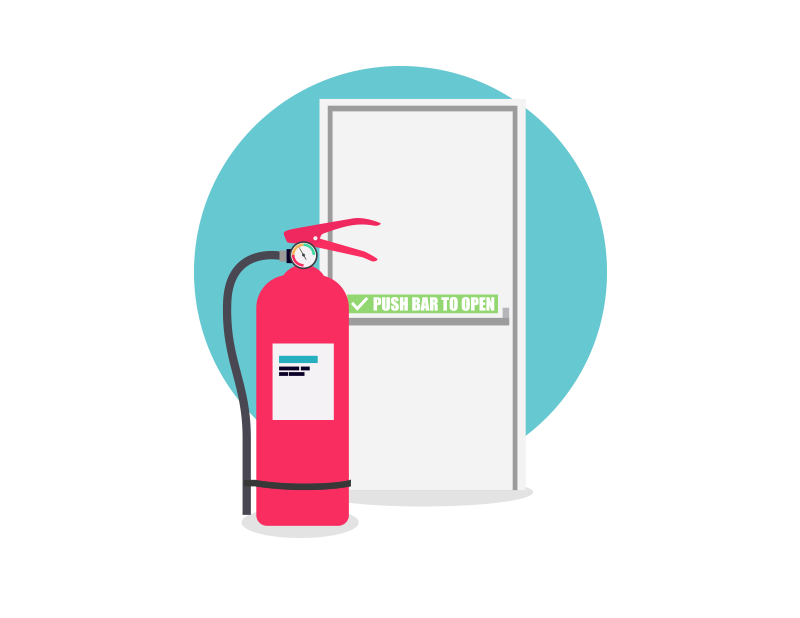Fire safety –FREE poster!
Fire safety is something every business should take seriously. To keep your team and your business safe, we have compiled advice from the Health and Safety Executive’s fire safety page, along with other respected voices in the field.
You can use this advice to help build your fire safety assessment (which you need to have, on top of your regular risk assessments).
What’s more, if you find this advice helpful, you can download a FREE Fire Safety poster to put up in your office or warehouse!
Minimise the potential for fires
Store flammable and combustible materials in secure, fire-resistant areas.
Be careful when using and moving flammable and combustible materials.
Keep sources of ignition away from flammable and combustible stores.
Remove naked flames and unnecessary heat sources.
Switch off and unplug electrical devices when not in use.
Reduce oxygen supply for potential fires by keeping windows and doors shut.
Update your fire risk assessment regularly.
Minimising danger to staff
Ensure fire exit signs, fire extinguishers and fire action notices are correctly placed.
Make sure you record who is on and off-premises at all times.
Keep fire exits closed. Fire exits and fire escape routes should be free from obstruction.
Where possible, have primary and secondary exit routes available.
You should have assigned members of staff who are trained up to date on your fire evacuation duties.
Build a fire evacuation plan that is actionable and considers all foreseeable circumstances, including supporting visitors and people with disabilities.
Maintenance of fire precautions
Things to check on:
Weekly:
Fire alarms and detection systems
Fire extinguishers and hose reels (remember to check the expiry date)
Fire doors and closing mechanisms
Monthly:
Emergency lighting
The visibility of fire signage
Quarterly:
Check fire exits and escape routes by ‘walking’ them (practising walking the entire route, noting any obstructions on the way)
If you discover a fire:
Operate the nearest fire alarm.
Fire marshals can try to tackle a fire, if they have the correct fire extinguisher and if it is safe to do so.
Leave the building immediately by the nearest exit. If it is safe to do so, close windows and doors on your way out.
Head to the nearest fire assembly point, where roll call will be held.
If you hear the fire alarm:
Leave the building immediately by the nearest exit. If it is safe to do so, close windows and doors on your way out.
Head to the nearest fire assembly point, where roll call will be held.
Contacting the emergency services
Make sure you are in a safe state to call the emergency services.
Dial 999 and request ‘fire’ services.
You may be asked:
Your contact number
A description of the incident
An exact location of the fire
NOTES: do not hang up partway through the conversation. The operator will terminate the call once they have all the information they need.
Make your team aware of any protocols you have for notifying the emergency services.
A guide to fire extinguishers
Red – water
For wood, paper, textile and solid material fires.
Do not use on liquid, electrical, or burning metal fires
Cream – foam
For oil, fat and liquid fires.
Do not use electrical or burning metal fires.
Blue – dry powder
For oil, fat, liquid and electrical fires.
Do not use on burning metal fires
Black – Carbon dioxide
For liquid and electrical fires.
Do not use on burning metal fires
Yellow – Wet chemical
For cooking oil fires.
Do not use on burning metal fires
Fire blankets are suitable for small fires such as in cooking, or clothing fires.
Get your fire safety poster, absolutely free!
How Safepoint can keep your team safe
Accidents happen, that’s why we’re releasing this new series of health and safety posters –to help you create the safest possible environment for your team.
But what if an accident happens and no one’s about to help? Safepoint provides smart tools, discreet panic alarms and a 24/7 remote supervision service for those who work alone or in high-risk roles.
To find out how we can keep your team safe, watch our explainer video or get in touch, below.
Note: Safepoint neither warrants nor represents that the information in this article is suitable for your purposes. It is recommended that you review the information in this article and seek advice in order to ensure that it suits your particular requirements and circumstances. Safepoint therefore accepts no responsibility for your use of the information in this article.












